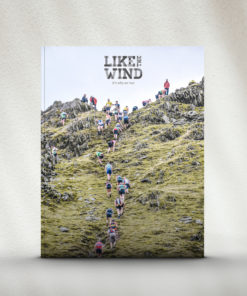Subtotal: $49.40
WORDS BY LIKE THE WIND – PHOTOGRAPHY SUPPLIED BY ZEN RUNNING CLUB
One of the great challenges in running today is finding a way to combine sustainability and performance in a running shoe. The planet demands shoes that do less harm, and runners demand footwear that ensures they’ll perform at their best. Zen Running Club is on a mission to create footwear that will fulfil both demands. And the brand intends to share the journey with everyone. Welcome to the FUTUREproject, a three-year mission to build a biodegradable super-shoe.

Running’s past is packed with seemingly impossible challenges that became realities, thanks to pioneers who paved the way for others. On 6 May 1954, 25-year-old medical student Roger Bannister won a one-mile race in Oxford in 3m59.4s and, in so doing, broke a barrier that many thought impenetrable: the four- minute mile. At the Amateur Athletic Union Championships at Public Schools Stadium in St Louis, Missouri, on 21 June 1963, sprinter Bob Hayes became the first man to run 100 yards in less than 10 seconds.
Entering the Los Angeles Colosseum on 5 August 1984 to take the gold medal, Joan Benoit-Samuelson became the first woman to win the Women’s Olympic Marathon, only a few decades after the International Olympic Committee had banned women from racing more than 800 metres.
Now high school athletes run sub-four-minute miles. A sub-10-second 100m is considered entry-level for international male sprinters. And in many big city marathons (although by no means all), women now represent close to half of all entrants.
But none of this would have happened without the pioneers.
HOW IT STARTED
The first true performance running shoes were really adaptations of everyday shoes, typically featuring leather uppers and soles. There were specific design elements – most notably a reduction in weight – that helped athletes perform better. However, these shoes were not dramatically different from the shoes people wore whenever they left the house.
But during the early 1900s, everything changed. Rubber- soled shoes with canvas uppers arrived on the scene, made possible by the technology of the time – which included new ways to vulcanise (harden) natural rubber.
Some running shoes still featured leather or suede uppers, but the middle of the 20th century saw the development of synthetic materials that were lighter, more durable and less prone to absorbing moisture. And then, during the 1970s, the next big leap forward occurred with the introduction of synthetic foam – ethylene vinyl acetate (EVA) – which was used to create superior mid-sole cushioning.
From that point onwards, running shoes were almost entirely made of plastic and synthetic materials. And the timing – coming alongside the explosion of the running boom of the 1980s – could not have been better. Production rocketed and the cost of running shoes dropped to a point where almost everyone who wanted a pair could afford them.
However, the unintended consequence of the collision of synthetic materials and increased interest in running was millions of pairs of non-biodegradable shoes making their way into landfill and incinerators… a situation that hasn’t really changed over the past 40 years.
Enter the team behind Zen Running Club. With backgrounds at some of the world’s biggest running shoe brands, the founders can clearly see the problem: as runners themselves, they demand an uncompromising approach to performance, yet wish they could achieve this with products that are not damaging to the very trails, tracks, hills and dales they enjoy. And so began their journey…
Working with like-minded innovators across the world, the ZRC team is combining its passion and know-how with a new generation of bio-based, biodegradable materials to create the impossible dream: a sustainable super-shoe.
HOW IT’S GOING
The team at Zen Running Club knows that it has embarked on a difficult journey. Along the way, the team members expect challenges and are prepared for failures. But, just like Bannister, Hayes and Benoit-Samuelson, they are committed to reaching their own milestones.
 For three years, Zen Running Club has been working closely with high performance athletes, everyday runners, experienced testers and select retailers to put prototypes of ZRC shoes through their paces. The first Zen Running
For three years, Zen Running Club has been working closely with high performance athletes, everyday runners, experienced testers and select retailers to put prototypes of ZRC shoes through their paces. The first Zen Running
Club shoe to be commercially reviewed was hailed as being “years ahead of any competition” in the sustainable space and indeed was compared favourably to the leading performance shoes from some of the biggest brands in running. This gave Zen Running Club a successful proof of concept, which the brand has since used as a springboard to the future. In partnership with athletes, suppliers and supporters, the ZRC team continues to innovate, test and evolve its proposition, creating proprietary solutions to be integrated into future shoe releases.
BUILDING A SUSTAINABLE SUPER-SHOE IN PUBLIC
From today’s vantage point, the founders understand that it might be difficult for observers to believe in the sustainable super-shoe. According to Richard Rusling, co-founder, the key issue is that “The consumer hasn’t yet been given the evidence to believe that a sustainable super-shoe can perform as well as an ordinary one.”
To work against those preconceptions, and to demonstrate that sustainability and performance are not mutually exclusive, Zen Running Club is building in public.
Behind this unusual (for the industry) impetus to go public, is Rusling’s feeling that: “We see the major issue as one of education and information-sharing, and that’s why we want to do this project in an open forum, with runners along for the ride.”
The story of building a biodegradable super-shoe will be told in front of the brand’s customers, involving them in the process, celebrating steps forward and explaining any setbacks that might occur. As Rusling says: “The main reason for this openness is that many regard the creation of a sustainable super-shoe as an impossible dream.” The ZRC team will share why, currently, this may indeed be seen as impossible, and then take the runner on an open journey towards the goal. They start this project with the Future One shoe. The project will roll out, chapter by chapter – with each step being a positive move forward, telling the brand’s story.
The final word goes to Rusling. “Our mission to create a biodegradable super-shoe holds us accountable on two levels,” he says. “One, to deliver on the performance levels expected by elite athletes, and the other to able to naturally decay in a way that is not harmful to the environment.”
GET INVOLVED
So how can you – the runner – get involved? Initially, simply by following the journey. Sign up to the Zen Running Club newsletter and read more about the mission at www.zenrunningclub.com.
The next chapters of the Zen Running Club journey will be written in future editions of Like the Wind. Welcome to the greatest race imaginable: to create a biodegradable super-shoe.
Get involved: www.zenrunningclub.com


 I Hope I See You On The Trail Art Print by Benjamin Mills
I Hope I See You On The Trail Art Print by Benjamin Mills  Issue Thirty of Like the Wind Running Magazine
Issue Thirty of Like the Wind Running Magazine 